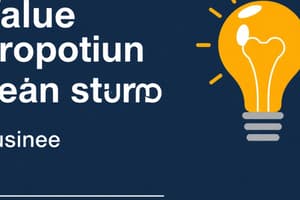Podcast
Questions and Answers
What is the name of a framework used to summarize business hypotheses?
What is the name of a framework used to summarize business hypotheses?
Business Model Canvas
What is the main goal of developing a business model?
What is the main goal of developing a business model?
- To make money (correct)
- To define a company's value proposition
- To identify and solve problems
- To attract investors
Which of the following is NOT a component of a business plan?
Which of the following is NOT a component of a business plan?
- Marketing
- Technology
- Customer Reviews (correct)
- Sales Channels
What is the main message of the quote "No Business Plan Survives First Contact with Customers."?
What is the main message of the quote "No Business Plan Survives First Contact with Customers."?
The cost-plus business model involves customers paying a fixed price for a product regardless of its actual cost.
The cost-plus business model involves customers paying a fixed price for a product regardless of its actual cost.
What is the primary difference between a cost-plus business model and an hourly rate model?
What is the primary difference between a cost-plus business model and an hourly rate model?
Which business model involves customers paying a low upfront cost and then recurring costs based on usage?
Which business model involves customers paying a low upfront cost and then recurring costs based on usage?
Which of the following business models relies on earning a commission from a third party for purchases made by customers?
Which of the following business models relies on earning a commission from a third party for purchases made by customers?
What is the main idea conveyed in the final takeaways slide?
What is the main idea conveyed in the final takeaways slide?
Flashcards
Business Plan
Business Plan
A comprehensive document outlining a business's strategy, including technology, market, competition, team, finances, and sales channels.
Executive Summary
Executive Summary
A concise overview of the business plan, typically one page long.
Lean Startup
Lean Startup
A method focusing on rapid iteration and customer feedback instead of lengthy business plans.
Business Model Canvas
Business Model Canvas
Signup and view all the flashcards
Business Model
Business Model
Signup and view all the flashcards
Revenue Generation
Revenue Generation
Signup and view all the flashcards
Market Understanding
Market Understanding
Signup and view all the flashcards
Customer Identification
Customer Identification
Signup and view all the flashcards
Sales Channels
Sales Channels
Signup and view all the flashcards
Cost Model
Cost Model
Signup and view all the flashcards
Hourly Rate Model
Hourly Rate Model
Signup and view all the flashcards
Leasing Model
Leasing Model
Signup and view all the flashcards
One-Time + Maintenance Model
One-Time + Maintenance Model
Signup and view all the flashcards
Licensing Model
Licensing Model
Signup and view all the flashcards
Consumables Model
Consumables Model
Signup and view all the flashcards
Add-On Products Model
Add-On Products Model
Signup and view all the flashcards
Advertising Model
Advertising Model
Signup and view all the flashcards
Reselling Data Model
Reselling Data Model
Signup and view all the flashcards
Transaction Fee Model
Transaction Fee Model
Signup and view all the flashcards
Usage Model
Usage Model
Signup and view all the flashcards
Cell Phone Plans
Cell Phone Plans
Signup and view all the flashcards
Penalty Model
Penalty Model
Signup and view all the flashcards
Study Notes
ENGG 525 - Business Models
- Course taught by Dr. Ghada Nafie at the Schulich School of Engineering.
- Business plans should be well-written, covering technology, market, competition, team, finance, and sales channels.
- A one-page executive summary is also necessary.
- Lean startup methodology emphasizes contacting customers first, summarizing hypotheses in a Business Model Canvas instead of a complex business plan.
- A business model is a method for a startup to make money by offering value to customers in a specific market segment.
- A business model clearly identifies who pays, how much, and for what.
- Key components of a business model include revenue, market, and customers.
- Revenue shows how a solution generates income.
- Market understanding is essential for successfully entering a market.
- Identifying customers and their purchasing methods is pivotal.
- Generalized business models exist; some can be hybrid.
- Different types of business models include Cost Plus, Hourly Rate, Leasing Model, Time + Maintenance, Licensing, Consumables, Add-On Products, Advertising, Reselling Data, Transaction Fee, Usage Model, Cell Phone Plans, Penalty Fees, and Micro Transactions.
- Cost Plus: Customer pays a percentage over product cost.
- Hourly Rate: Rewards activity, not progress.
- Leasing Model: Agreed-upon periodic payment.
- Time + Maintenance: Large upfront charge with ongoing upgrades/maintenance.
- Licensing: Customers license intellectual property (IP) and pay royalties.
- Consumables: Low upfront cost with usage-based ongoing costs.
- Add-On Products: Customers buy the main product and pay more for additional items.
- Advertising: Revenue through third parties reaching customers.
- Reselling Data: Reselling customer data to earn revenue from third parties.
- Transaction Fee: Commission from a party when customer makes a purchase.
- Usage Model: Customers pay for the amount of use.
- Cell Phone Plans: Customers pay for a committed usage amount.
- Penalty Fees: Small fee for basic service with substantial charges if necessary.
- Micro Transactions: Customers use their credit card for small digital purchases.
- Franchise: Others pay a startup for a business it creates.
- Innovative business models often emerge beyond established categories, or as hybrids.
- Business models are crucial for extracting value and are not static choices.
- Customers are receptive to fresh concepts.
Business Model Canvas
- Key components for a business model canvas include Problem, Solution, Unique Value Proposition, Unfair Advantage, Customer Segments, Key Metrics, Channels, Cost Structure, and Revenue Streams.
- Defining customer needs and developing a value proposition are crucial.
Studying That Suits You
Use AI to generate personalized quizzes and flashcards to suit your learning preferences.




